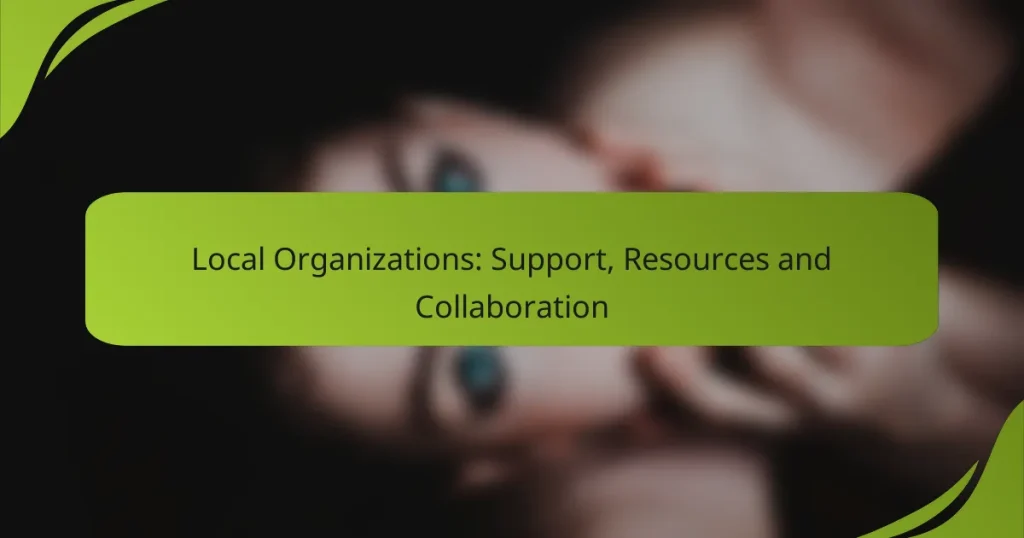Women’s health and rights initiatives are vital for empowering communities and addressing the unique challenges faced by women. By fostering collaboration and increasing awareness, these initiatives ensure that women have access to essential healthcare services and the resources needed to make informed health decisions. Grassroots organizations play a key role in this process, mobilizing local populations to advocate for policy changes and support community health programs.
Community Events: Impact, Awareness and Participation
Local Organizations: Support, Resources and Collaboration
Community Health Fairs: Effectiveness, Education and Outreach
Funding Opportunities: Sources, Strategies and Community Impact
Volunteer Opportunities: Engagement, Impact and Advocacy
How can community engagement improve women’s health initiatives?
Community engagement can significantly enhance women’s health initiatives by fostering collaboration, increasing awareness, and building support systems. When communities actively participate in health programs, they can better address the specific needs and challenges faced by women.
Increased awareness and education
Community engagement raises awareness about women’s health issues by disseminating information through local networks. Educational workshops, seminars, and health fairs can inform women about reproductive health, preventive care, and available resources.
For instance, local organizations can host events that focus on topics such as breast cancer awareness or maternal health, making information accessible and relevant to the community. This localized approach ensures that women receive tailored education that resonates with their experiences.
Enhanced support networks
Building strong support networks is crucial for women’s health. Community engagement facilitates the creation of groups where women can share experiences, seek advice, and provide emotional support to one another.
Support networks can take various forms, such as peer-led groups, online forums, or local meetups. These connections can help women navigate health challenges and access services, ultimately improving their overall well-being.
Empowerment through participation
Active participation in health initiatives empowers women to take control of their health decisions. When women are involved in planning and implementing health programs, they can advocate for their needs and influence policies that affect their lives.
Encouraging women to participate in decision-making processes not only boosts their confidence but also leads to more effective health solutions. For example, women can contribute to the design of health campaigns that reflect their cultural values and address specific barriers they face.
What are effective women’s health rights initiatives in the United States?
Effective women’s health rights initiatives in the United States focus on providing accessible healthcare services, advocating for legislative protections, and enhancing community health programs. These initiatives aim to empower women by ensuring they have the necessary resources and rights to make informed health decisions.
Planned Parenthood services
Planned Parenthood offers a variety of essential health services tailored for women, including reproductive health care, cancer screenings, and sexually transmitted infection testing. These services are often provided on a sliding scale based on income, making them accessible to a wide range of individuals.
In addition to clinical services, Planned Parenthood also provides education and advocacy on women’s health issues, helping to raise awareness about reproductive rights and health options. This dual approach supports both individual health and broader community engagement.
Women’s Health Protection Act
The Women’s Health Protection Act is a legislative effort aimed at safeguarding access to abortion services across the United States. This act seeks to prevent states from enacting restrictive laws that could limit women’s access to reproductive healthcare.
By establishing federal protections for abortion rights, the act aims to ensure that women can make personal health decisions without excessive governmental interference. Understanding the implications of this act is crucial for both healthcare providers and patients navigating reproductive health options.
Local health department programs
Local health departments play a vital role in promoting women’s health through various programs that address specific community needs. These programs may include maternal and child health services, family planning, and education on preventive care.
Engagement with local health departments can provide women with access to resources such as free or low-cost screenings, vaccinations, and health education workshops. Women are encouraged to explore these programs to take advantage of available services that support their health and well-being.
How do grassroots organizations support women’s health?
Grassroots organizations play a crucial role in supporting women’s health by fostering community engagement and providing essential resources. They mobilize local populations to address health issues, advocate for policy changes, and distribute necessary materials and information.
Community outreach programs
Community outreach programs are designed to connect women with health services and education. These initiatives often involve workshops, health fairs, and informational sessions that raise awareness about women’s health issues such as reproductive health, mental well-being, and preventive care.
Effective outreach programs typically engage local leaders and volunteers to build trust within the community. For example, a program might offer free health screenings or educational seminars in local schools or community centers, ensuring accessibility for all women.
Advocacy and policy change
Advocacy efforts by grassroots organizations aim to influence public policy to improve women’s health rights. This includes lobbying for better healthcare access, funding for women’s health programs, and legislation that protects reproductive rights.
Organizations often mobilize community members to participate in campaigns, write to lawmakers, or attend public hearings. By amplifying women’s voices, these groups can effectively push for changes that reflect the community’s health needs and priorities.
Resource distribution
Resource distribution is a vital function of grassroots organizations, providing women with access to necessary health supplies and information. This can include distributing contraceptives, hygiene products, and educational materials about health services available in the area.
Many organizations partner with local businesses and health providers to ensure a steady supply of resources. For instance, a grassroots initiative might set up a monthly distribution event where women can receive free health kits, thereby reducing barriers to accessing essential health products.
What role does education play in women’s health rights?
Education is crucial in empowering women to understand and advocate for their health rights. It enhances awareness of health issues, promotes informed decision-making, and fosters community support for women’s health initiatives.
Health literacy programs
Health literacy programs aim to improve women’s understanding of health information and services. These programs often include training on how to navigate healthcare systems, interpret medical information, and make informed choices about their health.
For example, a health literacy initiative might teach women how to read prescription labels, understand medical jargon, and recognize their rights within the healthcare system. Effective programs can lead to better health outcomes and increased confidence in managing personal health.
Workshops and seminars
Workshops and seminars provide interactive platforms for women to learn about various health topics, including reproductive health, nutrition, and mental well-being. These events often feature experts who share knowledge and answer questions, creating a supportive environment for discussion.
Participating in these sessions can help women build networks and share experiences, which is vital for community engagement. Local organizations may offer these workshops at little to no cost, making them accessible to a broader audience.
How can technology enhance women’s health initiatives?
Technology can significantly enhance women’s health initiatives by providing accessible resources, improving communication, and fostering community support. Tools like telehealth services, health tracking apps, and online support communities empower women to manage their health more effectively and connect with others facing similar challenges.
Telehealth services
Telehealth services allow women to consult healthcare professionals remotely, making healthcare more accessible, especially in rural or underserved areas. These services can include video consultations, phone calls, and messaging, reducing the need for travel and wait times.
When using telehealth, ensure that the platform is secure and compliant with local regulations, such as HIPAA in the United States. Many telehealth services accept insurance, but it’s wise to verify coverage beforehand to avoid unexpected costs.
Health tracking apps
Health tracking apps help women monitor various aspects of their health, including menstrual cycles, pregnancy, and general wellness. These apps often provide personalized insights and reminders, making it easier to stay on top of health goals.
When choosing an app, look for features that suit your needs, such as symptom tracking, medication reminders, or integration with wearable devices. Be cautious about data privacy and select apps that prioritize user confidentiality.
Online support communities
Online support communities offer women a platform to share experiences, seek advice, and find emotional support. These communities can be found on social media, dedicated forums, or health-focused websites, providing a sense of belonging and understanding.
Engaging in these communities can be beneficial, but it’s essential to approach shared information critically. Verify advice from credible sources and be mindful of the potential for misinformation. Look for communities moderated by healthcare professionals for more reliable guidance.
What are the challenges facing women’s health initiatives?
Women’s health initiatives face numerous challenges, including access to care, cultural barriers, and funding constraints. These obstacles can hinder effective program implementation and limit the reach of essential services.
Access to Healthcare Services
Access to healthcare services is a significant barrier for many women, particularly in rural or underserved areas. Factors such as transportation difficulties, lack of nearby facilities, and high costs can prevent women from seeking necessary medical attention.
To improve access, initiatives can focus on mobile health clinics or telemedicine options, which allow women to receive care without the need for extensive travel. Collaboration with local organizations can also help identify and address specific community needs.
Cultural and Social Barriers
Cultural and social barriers often impact women’s health initiatives, as societal norms may discourage women from discussing health issues or seeking help. Stigma surrounding certain conditions, such as mental health or reproductive health, can further complicate access to care.
Engaging community leaders and using culturally sensitive education programs can help break down these barriers. Tailoring messages to resonate with local values can encourage women to participate in health initiatives and seek necessary care.
Funding and Resource Limitations
Funding and resource limitations pose a significant challenge to women’s health initiatives. Many programs rely on grants and donations, which can be unpredictable and insufficient to meet growing needs.
To address funding issues, organizations can explore partnerships with private sectors or government agencies. Additionally, developing sustainable funding models, such as sliding scale fees or community fundraising events, can help ensure the longevity of health initiatives.





